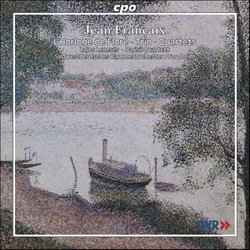| All Artists: Jean Francaix, Uri Segal, Françaix-Trio, SWR Stuttgart Radio Symphony Orchestra Title: Jean Françaix: L'Horloge de Flore; Trio; Quartets Members Wishing: 2 Total Copies: 0 Label: Cpo Records Original Release Date: 1/1/2006 Re-Release Date: 11/21/2006 Genre: Classical Styles: Chamber Music, Forms & Genres, Concertos, Historical Periods, Classical (c.1770-1830), Instruments, Reeds & Winds Number of Discs: 1 SwapaCD Credits: 1 UPC: 761203977925 |
Search - Jean Francaix, Uri Segal, Françaix-Trio :: Jean Françaix: L'Horloge de Flore; Trio; Quartets
 | Jean Francaix, Uri Segal, Françaix-Trio Jean Françaix: L'Horloge de Flore; Trio; Quartets Genre: Classical
|
Larger Image |
CD Details |
CD ReviewsFrançaix Chamber Music, Most of It Featuring Oboe or English J Scott Morrison | Middlebury VT, USA | 12/13/2006 (5 out of 5 stars) "The music of Jean Françaix (1912-1997) has long been special favorite of mine. For some reason I haven't been able to fathom his music has been more favored by German record labels than those of his native France. Wergo issued a whole series of LPs and then CDs with his music, and now here comes cpo with a delightful collection of some of his chamber music, most of it featuring the playing of oboist/English hornist Lajos Lencsés who, in spite of his Hungarian name and his position as principal oboe in the NDR Radio Symphony, is essentially a French player, having studied at the Paris Conservatoire. He uses a French oboe (and cor anglais) and clearly uses reeds in the French style, so that his sound is quintessentially French. This perfectly matches Françaix's style. The most familiar work here is the charming 'L'Horloge de flore' ('The Flower Clock'), a suite that contains seven pieces each of which depicts a flower whose blooms open at specific times of day. For instance, the galant de jour opens at 3AM, the cupidone bleue at 5AM and right on through to the silène noctiflore which opens at 9PM. A suite for oboe solo and chamber orchestra (here the orchestra is the NDR SO under the direction of Uri Segal), this is music that could easily be thought to be by one of Les Six. Delicate, spry, witty, charming. And beautifully played by Lencsés and colleagues. The Quartet for English Horn, Violin, Viola and Cello is also light-hearted. Unusually the English horn, in addition to being used in its typical melancholy manner, becomes a prankster, particularly in the helter-skelter Scherzo. The strings are members of the Parisii Quartet. The Trio for Oboe, Bassoon and Piano is probably my favorite work here, if only because I'm an old pianist and this is the only work with piano, played nimbly here by Françaix's daughter, Claude. The fine bassoonist is György Lakatos and he really shines in the gorgeous Andante. The Trio's scherzo burbles along in such good humor that I recommend it as medicine for anyone who is downhearted. The String Quartet, played here by the Parisii Quartet, is a 12 minute miniature that nonetheless consists of the usual four movements. Françaix wrote this at age 22 and dedicated it to his parents, who were his first music teachers, and to the woman with whom he was in love and who became his wife. His expansive spirits are present throughout. Even if you don't know any of Françaix's music (and let's face, he's not as well-known as I wish he were) you almost certainly will not be disappointed with this issue. It's definitely a keeper. Strongly recommended. Scott Morrison" Colorful Chamber Music D. A Wend | Buffalo Grove, IL USA | 06/26/2008 (5 out of 5 stars) "The music of Jean Francaix is among my favorites and this disc has some of his most sublime works. L'horloge de Flore is a short suite that describes flowers as they open at various times of the day. The work is for an oboe soloist and orchestra with the oboe seeming to describe the flower as it opens. The flowers come close to representing the entire day beginning at 3:00 AM and going until 9:00 PM. Throughout, the suite provides us a highly colored array of flowers mixed with gentle good humor.
The Quartet for English horn, Violin, Viola and Cello struck me as a very novel work. The quartet is in five short movements beginning with a sprightly allegro vivace and moving on to a beautiful andante where the English horn leads with a somewhat melancholy melody. The tempo picks up again in the Vivo assai with a playful interchange between the English horn and strings and is followed by an Andantino that is stately and sweetly melancholy. The finale returns to the playful exchange between the instruments and brings the Quartet to a joyous close. The Trio for Oboe, Bassoon and Piano is another remarkable combination of sounds and is in four movements. The instruments play off each other with remarkable sounds, the oboe and bassoon continually having a dialogue (except in the Adagio) with the piano providing the foundation (but manages to inject itself here and there). The String Quartet in G (1934) rounds out the CD; it is a beautifully written work with subtle color shadings demanded of the players. The players also interact with each other with individual players taking the lead on melodies but always joining together. The Quartet exhibits the marvelous good humor associated with Francaix's music that made German music lovers think of him as the quintessential Frenchman. The music is beautifully recorded and the accompanying booklet is very informative. " |

 Track Listings (20) - Disc #1
Track Listings (20) - Disc #1